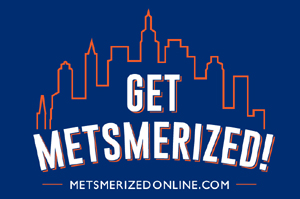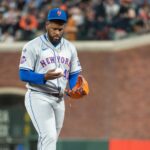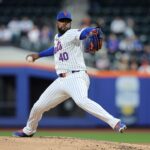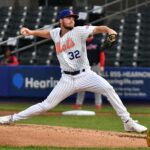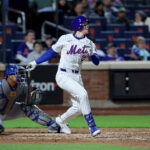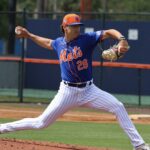After the New York Mets squared off against the New York Yankees for five games in the 2000 World Series, it would be six years until they made it back to the postseason.
From 2001 through the 2005 season, the Mets finished no higher than third in the National League East, while placing dead last in back-to-back seasons in 2002 and 2003.
The early-to-mid 2000 teams featured a heavy dose of veteran talent – some on the backside of their careers – with some young talent on the horizon in José Reyes and David Wright.
Those clubs also featured a bevy of role players and guys who were fun to root for, whether it was Joe McEwing, Todd Zeile, or Dae-Sung Koo. Another player who brought his own personality to a lackluster period of Mets baseball was catcher and first baseman, Jason Phillips.
Phillips, 46, was a 24th-round pick out of San Diego State University in the 1997 Draft and only had a few years of catching experience prior to signing with the Mets. As a kid, Phillips had aspirations of playing shortstop, however, his slow-footedness – which he was dubbed one of the slowest players in baseball – prevented Phillips from continuing to play up the middle.
He was signed as an organizational filler, a guy who could catch and log innings behind the dish. Phillips had two early tastes of the majors as a September call-up in both 2001 and 2002, playing in a combined 17 games and collecting eight hits in 26 at-bats (.308 batting average).
In 2003, Phillips made his first Opening Day roster and went back and forth between Queens and Triple-A Norfolk early on in the season before returning for good in mid-May.
Splitting time between catcher and first base, the right-handed hitter appeared in 119 games in ’03, posting an OPS of .815 with 11 home runs and 58 RBI. His 117 wRC+ was the fourth-highest mark on the team that season (min. 250 plate appearances), while boasting the highest OBP with runners in scoring position with a .420 mark (min. 50 plate appearances).
Aside from his inspired play in ’03, a notable feature Phillips was known for was his style selection: wearing black goggles on the field due to an astigmatism. The eyewear added to Phillips’ persona and made him a recognizable figure during those seasons.
Phillips last played in the majors with the Toronto Blue Jays in 2007, appearing in 55 games as primarily a catcher. Post-playing career, Phillips has kept involved in the game in a variety of ways. He’s worked as a major league bullpen catcher for both the Seattle Mariners and Toronto Blue Jays, a bullpen coach for the New York Yankees’ Double-A affiliate and now works as a national scouting coordinator for Perfect Game USA, an organization devoted to promoting amateur players through showcases and tournaments.
Phillips actively keeps up with the Mets – his wife grew up a Mets fan in Buffalo, New York, – and has aspirations of getting back in their organization in some capacity. Though, Phillips’ ultimate dream is to manage in the majors, a lofty goal but one in which Phillips feels he can excel in.
“I’m a baseball lifer,” said Phillips. “This is what I live for.”
I had the privilege of speaking to Phillips where he discussed balancing catching and first base in the majors, eyewear choices and his work at Perfect Game.
MMO: Who were some of your favorite players growing up?
Phillips: Darryl Strawberry was one. I always loved his play and I wondered what it was like to be in New York at that time. To then be drafted by the Mets and come up with them was a dream come true [for me]. Coming from San Diego, I knew more Mets players than I did Padres, just because there were no local televised games.
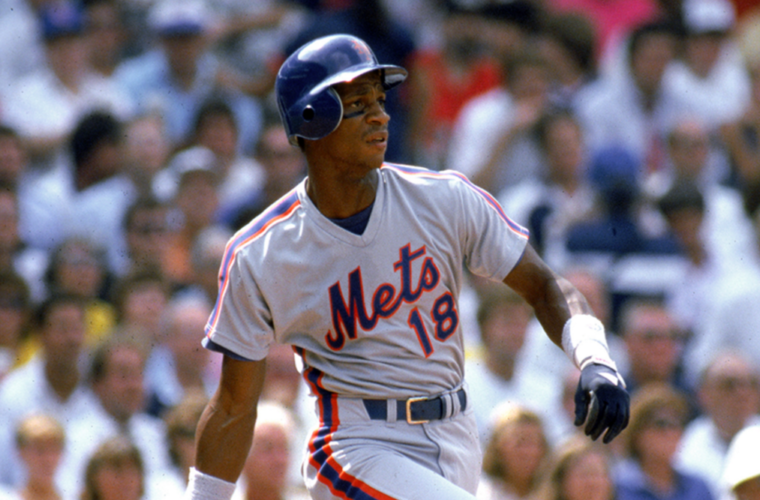
And more than that, I knew the Braves just because of TBS and all the games that were on. My favorite player as a young kid was Dale Murphy because I saw him all the time.
The Mets are always going to be my team, they gave me my first chance. I’ve been trying to get back with them for years on the coaching side, I just can’t get a break and get back in.
My wife is from Buffalo, New York, she grew up a Mets fan. And not saying we didn’t like the Yankees, but it was always like the Evil Empire. When you get drafted by the Mets and come up through their system, it’s just ingrained in me that we might not be that good this year at whatever level, but we can’t lose to the Yankees. [Laughs.]
MMO: You came up through the Mets’ system as a catcher, and transitioned to first base while in the majors. What was that adjustment like for you? How would you stay physically and mentally prepared for both?
Phillips: One thing I tell kids when I used to work camps is I wanted to be a shortstop. My dad would hit me ground balls in the street with a Nerf baseball that had the extra hop every night. That was our father-son time. If you remember my playing days, I think I was voted the slowest player in the big leagues three years in a row. [Laughs.] Shortstop was definitely not my future.
I tried third base, but I wasn’t physically strong. I went to college at six-foot-one, one-hundred seventy [pounds]; I didn’t mature until later in life. You look at any big leaguer and they’re strong. If you can’t hit a ball, even pitchers, throwing BP to pitchers, everybody on a big league team can hit a ball out of the park to the pull-side. You have to be physically strong to compete.
You’re going to break down throughout the year, you’re talking eight months out of a calendar year. At the end of the season you need some downtime, and then you’re right back in it. It’s a daily grind, even for the superstars.
I only caught my senior year in high school and two years in college. I basically caught three years before I got to the Mets. When I got drafted as a 24th round pick [in 1997], I’m just a roster filler, an organizational guy. The thought process was he can catch and throw, and if he hits whatever; we’ll give him a few years in the minors and we’ll go get somebody else. I had nothing to lose.
When I got drafted they said, “You are no longer an infielder. You don’t take any grounders, you won’t play in the field. You’re strictly a catcher.” In 2003, I was hitting good in Triple-A and Mo Vaughn went on the disabled list and Tony Clark was playing first base. They said, “Hey, can he (Phillips) play first?” I said, ‘Give me a glove.’
I literally had three games at first base in Triple-A. [Mike] Piazza had the injury and I got called up. Matt Galante taught me how to play first base, we were out there every game.
I learned how to play first base in the big leagues and that’s where I got the appreciation that it’s one of the more difficult positions on the field to play because every ball that’s hit you have to go somewhere. I don’t think a lot of people teach that. Every ball that’s hit you’re either covering first, making a cut, going here, going there. Even Robin Ventura was like, “Yeah, I like when the ball’s hit over there because I just stand here. You have to go somewhere every time!” I told him I was learning that real fast! [Laughs.]
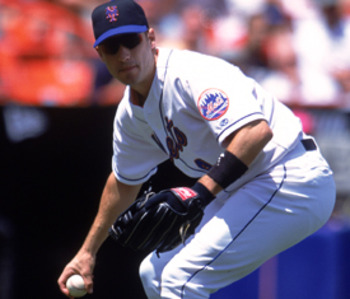
When you’re playing behind a runner with first and second and there’s a ball hit to center, that’s a long run for me to get to that cut guy behind the mound. When you’re on defense, the third baseman is talking to the shortstop about if a ball’s hit here, where am I going with it. Roberto Alomar helped me out tremendously being at second. He was like, “If this guy push bunts here, I’m going for it. You just go to the bag.”
All that stuff is sped up now so you really have to think two-to-three pitches ahead, and two-to-three hitters ahead. It’s a chess game that’s going on where nobody knows what the other guys are thinking and all nine guys have to be on the same page. Those are the teams that win.
MMO: Prior to the ’97 Draft, you got the chance to play in the Alaska Baseball League. What was your experience like in that collegiate summer league?
Phillips: Fortunately, the host family I was staying with was right near the stadium, so we just walked to and from the field. I could go over there any time to get extra work in. I lived in the basement and the sun really doesn’t go down ever in the summer, so I had to put foil on the windows. [Laughs.]
I was playing for Fairbanks, which is the northernmost city that you play in. We had a Midnight Sun Game that started at 10 p.m. and they never turned on the lights. The game finished at 1:00 a.m. and you just played through it, it’s an annual thing. It gets dusk and then by one the sun is rising from behind the hills, so it really never gets dark. People have some trouble sleeping and losing track of time
The first place we went to was Kenai, and we were staying in a bingo hall right on the mouth of the Kenai River. And a moose came up right by the bingo hall. We’ve got ten-to-twelve guys out there with a moose and two calves twenty feet away! You’re like, ‘Okay, this is a little different.’
The wildlife and scenery is amazing. Playing in the Cape or any summer league, you’re going to play with guys from all over the country and get an appreciation for the talent.
MMO: You mentioned your 2003 season before, which was your best season in the majors. You hit .298 with 25 doubles, 11 home runs and an .815 OPS in 453 plate appearances. Was there anything in particular that you remember working well for you that season?
Phillips: I tried not to strike out. [Laughs.] I hit into a lot of double plays, I couldn’t run, so I just tried to shorten my swing and go out there and play hard.
Catchers in the minor leagues play, for the most part, if you’re the starting catcher, two maybe three days in a row and then you get an off day. Your off day is usually the day game. So you know every night game I’m going to play and every day game I’ll have off. When I got to the big leagues I was playing every night game at first base and I was catching every day game. So the body physically flip flopped.
Catching is a more strenuous position and it was during day games when I was used to having an off day body-wise for four or five years as I was coming up. I think I was hitting around .330 going into September, and in September you’re playing against division teams more. They’re going to know more of your strengths and weaknesses just because they have more data and scouting reports on you, and I got tired.
I don’t know how many at-bats I had in the minor leagues but when you get to the big leagues now you’re talking about 500 when you’re used to getting 350. It’s a big step.
I learned how to stay hydrated, have better nutrition, when to take some time off from extra work and how to lift without being sore.
MMO: What was it like working with and having Mike Piazza as a teammate?
Phillips: Coming up with Piazza it was, ‘Hey, Mike, what do you need? What can I do for you because I’m just happy to be in the same clubhouse as you.’
In ’03, I believe it was just Ty Wigginton and I that had less than seven or eight years in the big leagues. You’re talking Al Leiter, Johnny Franco, [Mike] Piazza, [Steve] Trachsel, Roberto Alomar, [Robin] Ventura. You’re looking at the guys and thinking these guys are my idols, and now I have to try and do what I can to try and fit in. [Laughs.]
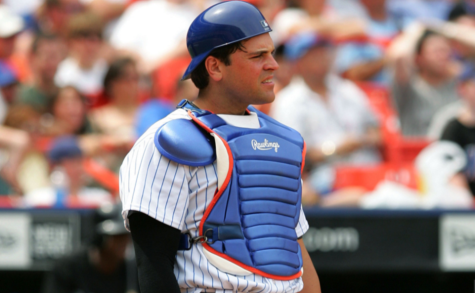
If you’re a rookie or have less than three years, you want to be one of the first to show up. Everyday it would be Jeromy Burnitz, Tony Clark, Joe McEwing, myself and Wigginton, and the five of us would go down to the cage. And you’re just learning and talking. You’re letting them talk and trying to soak up everything they do, and it makes you feel part of something. That’s where team and the camaraderie between players is built.
MMO: Your selection of eyewear on the field will always be something Mets fan attribute you with. I read you wore those goggles due to an astigmatism, is that right?
Phillips: Yes, I had astigmatism. As a right-eyed dominant, right-handed hitter, I really had to make sure that I could see more from the backside. I had to have both eyes on the ball with glasses. And you’re always pressing them to try and get them as close to your face as you can.
In the minor leagues, the Mets had a contract with Rex Specs, the Chris Sabo big goggles with the band and all of that. It was hard trying to get them not to fog.
When guys start struggling offensively they think: how’s my swing? How’s my timing? It’s like, wait a minute, let’s check your eyesight first. Let’s do some things. How’s your peripheral? Are you seeing this over there? You don’t see the ball the last eight to ten feet because of velocity, so that’s where your hand-eye coordination comes in. If your eyesight is good then okay, let’s get into the mechanics.
MMO: There’s a YouTube video of an interview you gave with Dr. Rolando Toyos, an ophthalmologist who worked with many sports organizations, on a DVD you two put together called “Vision & Baseball.” How did you first meet Dr. Toyos?
Phillips: I was too hesitant and scared when LASIK first came about in the early years. If I can’t see, my career is over. I was hesitant to go even though it would help me. But I didn’t want something to go wrong.
I was hesitant until I got to Toronto. In ’07, I signed my only one-year guaranteed contract. I was like, ‘Okay, I don’t know what’s going to happen, but I’m going to take a leap of faith and get the surgery.’ He (Dr. Toyos) corrected me to what a normal person who has a 9 to 5 job has, where you saw 20/20. I saw great! But in baseball, you need to see the ball even better. If I can put any sort of lens or glass in front of my eye to see better, correct me to that!
I had my first surgery before the start of the ’07 season. I went to spring training and I wasn’t hitting the ball all that well. I was kind of losing the ball when I was hitting because I was more right-eyed dominant. So in ’07, I still wore glasses but they were really not a very strong prescription.
At the end of ’07, I had another one (surgery) to go correct it a little bit more where I couldn’t put another frame in front of my eye and see better.
I always bring up Ted Williams. The guy was a WWII fighter pilot, his vision was off the charts! He saw every spin, every rotation, every seam. Besides him being the best hitter generationally, his eyesight was better than 99 percent of the human race.
MMO: Post playing career, you worked as a bullpen catcher for both the Mariners and Blue Jays. What are some of the responsibilities that you had?
Phillips: You’re kind of on call for anything. You have your pitchers who are going to throw their sides, but you’re also out there everyday with the pitching staff and that’s where you’re building rapport with guys. They’ll tell you things that they wouldn’t necessarily tell the coach, manager or trainer. So you have a reference and you get some insider trading tips. And that’s what it is: it’s information.
Jack Wilson, when he was with Seattle, he’d come off the field after a game and go, “J.P., can we go down to the cage?” He’d want to hit right after the game if he wasn’t feeling good. So you’re just kind of on call basically. Whatever I can do to help because I’m not playing anymore, I need you to play the best you can and feel the best you can.
MMO: Your Twitter profile states that you’re working for Perfect Game as a national scouting coordinator in Atlanta. Can you talk about how that came about?
Phillips: I was down in Tampa when Covid hit. I’m a Covid causality for three years now; out of the coaching ranks and coming to Perfect Game. I was living in Tampa with the Yankees there and they (Perfect Game) asked me to move out to Atlanta because it’s the hotbed for high school baseball. All the big tournaments come through, and four of the top eighteen picks last year were within a 20-mile radius of Atlanta. The talent level is here, and the talent level from California, Texas, Florida, the Northeast and Midwest all come to Atlanta for our big events.
You get to see the amateur players that are going to be drafted high this year or go onto major college schools. We have to scout everybody and we’re just trying to give exposure. When you have a guy like Max Clark or Walker Jenkins or Dylan Lesko from last year or Termarr Johnson, everybody knows who they are. You don’t even have to be a scout to watch a game and go, wow, that guy’s really good! It’s the other guys you’re projecting; this guy has a projectable frame, he throws strikes, he can put on a little size as he matures.
You try and give these guys some exposure so they can get scholarship money and play after high school. Not everybody that you’re watching here at Perfect Game is going to play in the big leagues; they’re not all going to play in Division I level power schools. It’s a tough game. You try to tell them that only seven percent of high school kids go on at any level past high school. So what can we do to try and promote them so that they can hopefully get an opportunity to play at the next level and get some money?
MMO: Thanks so much for taking some time to speak with me today, Jason.
Phillips: No problem. Good to talk with you.
Follow Jason Phillips on Twitter, @JPrecspecs
